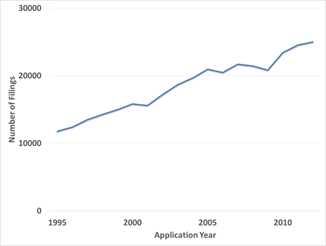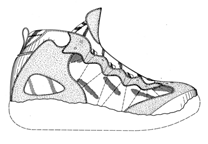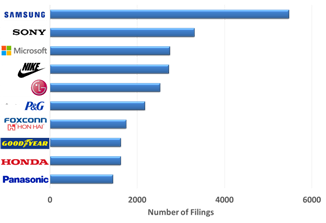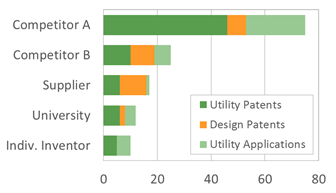POSTED BY Justin Kunz AT 1:05 P.M. June 30, 2015
From smartphones to yoga clothing, sinks to software icons, design patents are the trending asset in intellectual property (IP) circles. Investments in design patents, which protect an article’s look or ornamental design, have been steadily increasing over time (see Fig. 1). Based on recent trends, we expect an increase in strategic focus on this IP asset, which will likely include an influx of new design applications into the U.S. Patent & Trademark Office (USPTO), as well as other patent offices around the world.

Fig. 1: U.S. design patent filings over time
Sources: ipCapital Group
Here are the key reasons why we are advising our clients to increase their focus on design patents:
1. Damages
In the notable Apple v. Samsung smartphone IP war1, Apple extracted roughly $400 million dollars of damages based on three design patents2. The damages equated to the total profit on the sale of the accused Samsung phones, not just the profit related to the designs or ornamental aspects actually covered by the patents in question. The award is attributable to the 1887 design patent statute that, unlike utility patents, eliminates the need to apportion between patented designs and infringing articles.
2. Scope

Fig. 2: Design patent at issue
in Nike v. Wal-Mart Stores (138 F. 3d 1437), which applied the same
damages statute later affirmed in
Apple v. Samsung
Recent legislation has made it easier for innovators to expand the scope of design patent protection. As of May 13, 2015, in accordance with the Patent Law Treaties Implantation Act (PLTIA) of 2012, inventors may utilize an international design application to seek design protection in different countries. This streamlines the process and reduces costs for those who wish to obtain protection across multiple foreign jurisdictions.
Another benefit of the PLTIA: a single design patent application may contain up to 100 unique designs. This provides innovators with more flexibility when deciding which specific design or designs to commercialize. Software designers, who should protect the layout and various animated states of their user interface, particularly benefit.
Finally, the PLTIA also increased the term of a US design patent by one year3. A US design patent now expires 15 years after its date of issue.
3. Costs
The costs of obtaining design patents should be quite attractive to innovators, especially those who are accustomed to investing in utility patents. According to Doug Yerkeson, a partner at Faegre Baker Daniels LLP based in Indianapolis, legal fees associated with the preparation of a design patent application typically range between $500 to $2,000, depending upon complexity (e.g., number of design embodiments, alternate claiming strategies, etc.). In comparison, average legal fees for preparing a simple utility patent application is $6,5004. Fees paid to the U.S. Patent & Trademark Office (USPTO) for design patents are about 50% lower than utility patents. And unlike utility patents, which have increasing maintenance fees due after issuance, design patent holders pay no additional fees over the 15-year life of the asset5.
4. Marketing
Design patents typically represent the quickest & most cost effective way to obtain a “Patent Pending” mark on a product, which has many potential benefits. It demonstrates to prospective financiers, distributors or customers that an article is unique and differentiated. Marking also acts as a “no trespassing” warning to potential competitors who might benefit by copying saleable features. For those that ignore such warnings, marking also enables patent owners to recover broader scope of remedies (e.g., damages).
All U.S. design patent applications remain secret until the USPTO issues the granted patent. Thus, third parties will not be able to discern which aspect of the ornamental design is patent pending. This often discourages competitors who might otherwise seek ways to “invent around” a design and enter the marketplace with a competing product.
5. Valuation

Sources: ipCapital Group
By including design patents as part of a technology or IP portfolio, an innovator may be able to increase their valuation. In the case of smartphones, for example, Apple’s design patents protect a look and feel that consumers are willing to pay for and thus, are attributable to the increase in Apple’s sales of articles embodying this feature. Thus, one approach for estimating the value of Apple’s design patents is through the value of forecasted sales.
Design patents can also increase the valuation of an IP portfolio by hedging against the IP risk factors associated with utility patents. For example, design patents may increase a patent holder’s ability to detect infringement and/or withstand validity challenges. High tech clients may find the latter particularly important, especially in light of the uncertainty surrounding utility patent reform. In instances where innovators can only secure narrow utility protection, adding design patents may increase the difficulty with which third parties can invent around the IP.

Fig. 4: Example chart illustrating third-party design patent rights
Design patents in IP strategy
Many different companies & industries invest in design patents as part of their IP strategy (see Fig. 3). For example, Nike’s FuelApp is protected by about 20 design patents6. For those looking to do the same, here are several guiding principles for defining future actions that your organization should consider:
- Recognizing the areas (e.g., products, technologies) within your business where innovation in design occurs;
- Understanding how well your current design patent portfolio protects your business;
- Building awareness and managing risks associated with design patents owned by third parties (see Fig. 4); and
- Creating new design patents to achieve your organization’s mission and goals.
Design patents can be an effective part of an intellectual property strategy, along with utility patents, copyrights, trademarks, and trade secrets. To further discuss your particular situation, please contact us. Special thanks to Doug Yerkeson, Partner at Faegre Baker Daniels LLP and Jeff Goodwin, Senior Associate at ipCapital Group, for their contributions to this article.
1. http://law.justia.com/cases/federal/appellate-courts/cafc/14-1335/14-1335-2015-05-18.html
2. http://www.ipwatchdog.com/2015/01/06/an-opportunity-for-clarity-in-design-patent-damages/id=52956/
3. http://patentlyo.com/patent/2015/02/changes-design-coming.html
4. American Intellectual Property Association’s (AIPLA) 2013 Economic Survey
5. http://www.uspto.gov/learning-and-resources/fees-and-payment/uspto-fee-schedule
6. http://www.ipwatchdog.com/2013/08/06/strong-design-patents-the-power-of-color/id=44342/

